Fengguan
Fengguan (Chinese: 鳳冠; pinyin: fèngguān) is a traditional type of Chinese headgear for women. It was worn mainly by noblewomen during the Ming dynasty for ceremonies or official occasions. It is also traditional headgear for brides.
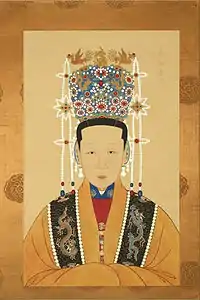
Fengguan means "phoenix crown", a name that originates from its adornments: phoenixes made of inlaid kingfisher feathers, as well as gold dragons, beaded pheasants, pearls, and other gemstones. One of the earliest phoenix crowns that has been excavated belonged to Empress Xiao of the Sui dynasty.[1] The type became most popular during the Ming Dynasty, with many changes made over time.
Design
Kingfisher feathers were extremely rare during the Ming Dynasty and were potentially sourced from Cambodia.[2] The numbers of phoenixes, dragons and precious gems on each crown is different. For example, the phoenix crown of Ming Empress Xiaoduanxian has 6 dragons, 3 phoenixes, 5,449 pearls, 71 rubies, and 57 sapphires.[3] Other phoenix crowns of empresses excavated from the Ming tombs have 9 phoenixes, between 12 and 9 dragons, more than 3,500 pearls, and more than 150 gemstones.[3] The pearls, gemstones and kingfisher feathers were made into ornamental flowers, leaves, clouds, and temple ornaments (Chinese: 兩博鬢; pinyin: liǎngbóbìn; the 'wings' at the sides and back of the crown). The weight of the entire crown can range from 2–3 kilograms (4.4–6.6 lb).[4]
Styles
There are different varieties of phoenix crown. The number of dragons, phoenixes and pheasants, in addition to the presence of certain ornaments was dictated by rank.[5]
Empresses
Decorated with 12-dragons-9-phoenixes crown (十二龍九鳳冠), 9-dragons-9-phoenixes crown (九龍九鳳冠), 9-dragons-4-phoenixes crown (九龍四鳳冠),[5] 6-dragons-3-phoenixes crown (六龍三鳳冠), and the 3-dragons-2-phoenixes crown (三龍二鳳冠). Only the crowns of empresses and crown princesses (wife of crown prince) can have temple ornaments adorned, with the empress's crown having 6 blades of temple ornaments (3 on each side).
Imperial concubines and princesses
9-pheasants crown (九翟冠), 7-pheasants crown (七翟冠) and 5-pheasants crown (五翟冠), adorned with beaded pheasants and gold phoenixes, are worn by royal concubines and princesses (includes wives of princes), with the number of pheasants representing the wearer's royal rank.[5] The crown princess can only have 4 blades of temple ornaments (2 on each side)
Noblewomen
All other noblewomen/wives and daughters of officials wear the pearl-and-emerald crown (珍珠翡翠冠), where the crown is just adorned with pearls and gemstones (in various ornamental shapes).[5][6] Phoenix crowns worn with diyi have no strings of pearls by the sides of the head. Noblewomen cannot have temple ornaments on their headdresses.
Gallery
 Tang Dynasty phoenix crown worn by Empress Consort Wu
Tang Dynasty phoenix crown worn by Empress Consort Wu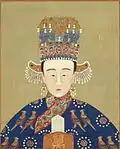 Ming Dynasty phoenix crown worn with diyi
Ming Dynasty phoenix crown worn with diyi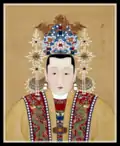 Ming Dynasty phoenix crown with strings of pearls
Ming Dynasty phoenix crown with strings of pearls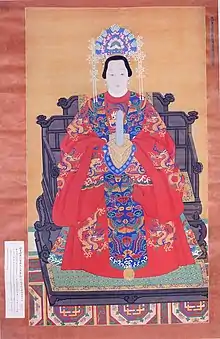 Ming Dynasty noblewoman wearing a crown with 9 pheasants and traditional Ming dress
Ming Dynasty noblewoman wearing a crown with 9 pheasants and traditional Ming dress Ming Dynasty noblewoman wearing a crown with 5 pheasants and traditional Ming dress
Ming Dynasty noblewoman wearing a crown with 5 pheasants and traditional Ming dress Ming Dynasty phoenix crown with 6 dragons and 3 phoenixes
Ming Dynasty phoenix crown with 6 dragons and 3 phoenixes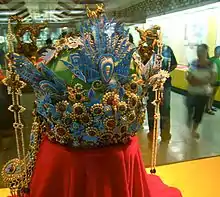 Ming Dynasty phoenix crown with 6 dragons and 3 phoenixes belonging to Empress Xiaoduanxian
Ming Dynasty phoenix crown with 6 dragons and 3 phoenixes belonging to Empress Xiaoduanxian Ming Dynasty phoenix crown with 9 dragons and 9 phoenixes
Ming Dynasty phoenix crown with 9 dragons and 9 phoenixes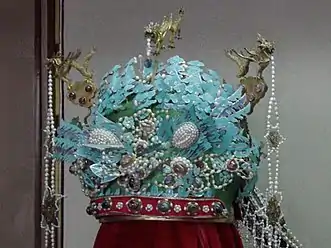 Ming Dynasty phoenix crown with 3 dragons and 2 phoenixes
Ming Dynasty phoenix crown with 3 dragons and 2 phoenixes Ming Dynasty empress's phoenix crown with 3 dragons and 2 phoenixes. The temple ornaments are laid by the sides
Ming Dynasty empress's phoenix crown with 3 dragons and 2 phoenixes. The temple ornaments are laid by the sides View of the reverse of a Ming Dynasty empress' phoenix crown with 3 dragons and 3 phoenixes
View of the reverse of a Ming Dynasty empress' phoenix crown with 3 dragons and 3 phoenixes Bride wearing a phoenix crown for a wedding
Bride wearing a phoenix crown for a wedding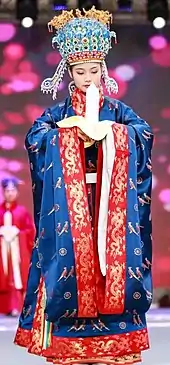 Diyi worn with phoenix crown
Diyi worn with phoenix crown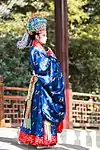 Diyi worn with phoenix crown (side view)
Diyi worn with phoenix crown (side view) Dashan (大衫) worn with phoenix crown
Dashan (大衫) worn with phoenix crown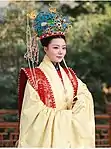 Dashan (大衫) worn with phoenix crown (side view)
Dashan (大衫) worn with phoenix crown (side view)
References
Notes
Cited works
- "Ancient phoenix crown of Sui Dynasty unveiled in E China". China Daily. 19 September 2016. Retrieved 14 February 2017.
- Women's head-wear of Ming Dynasty "明代妇女的头饰", Jlsdaj.gov.cn, Retrieved 2009-12-08
- Liu, Jensen (27 July 2008). "Phoenix Crown: Empresses' Luxury Headdresses". ChinaBlog.cc. China Blog. Retrieved 14 February 2017.
- "文物鉴赏" [Appreciation of cultural relics]. Ming Tombs (in Chinese). Special Administrative Agency for the Thirteen Mausoleums, Beijing. 29 December 2015. Retrieved 14 February 2017.
- Song, Yuxian (2015). The Power of the Phoenix Crown: Imperial Women and Material Culture in Late Ming China. Education & Research Archive, University of Alberta Libraries (MA). University of Alberta.
- zhaoxiaoyan (29 June 2015). "明朝服饰:明代妇女的头饰" [Ming Dynasty dress: Ming women's head-wear]. Qulishi (in Chinese). Qulishi. Retrieved 14 February 2017.